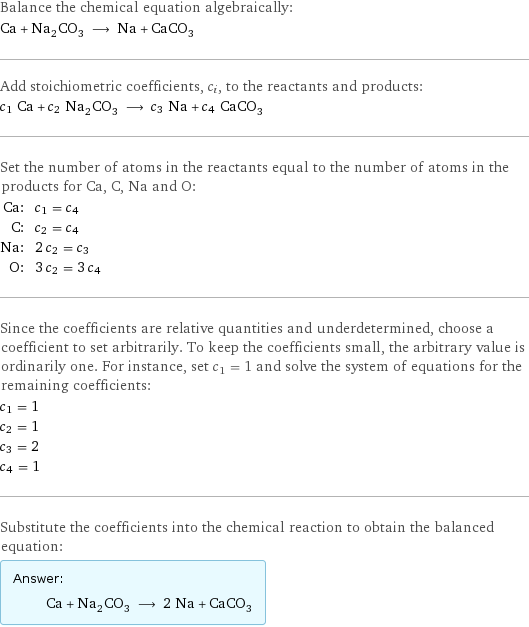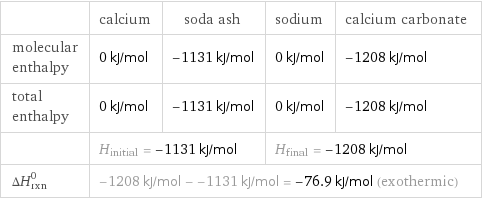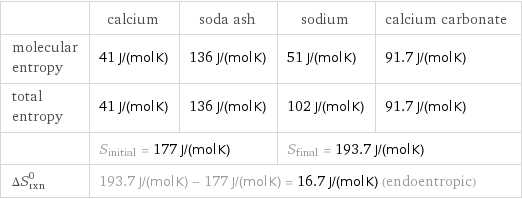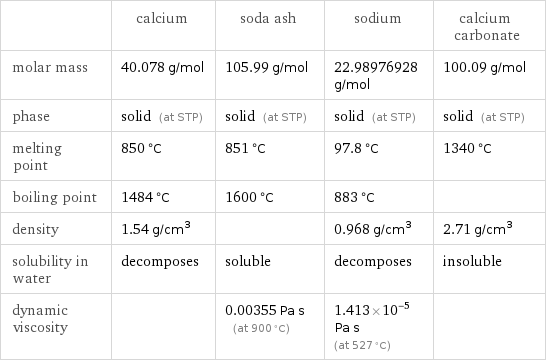Input interpretation

Ca calcium + Na_2CO_3 soda ash ⟶ Na sodium + CaCO_3 calcium carbonate
Balanced equation

Balance the chemical equation algebraically: Ca + Na_2CO_3 ⟶ Na + CaCO_3 Add stoichiometric coefficients, c_i, to the reactants and products: c_1 Ca + c_2 Na_2CO_3 ⟶ c_3 Na + c_4 CaCO_3 Set the number of atoms in the reactants equal to the number of atoms in the products for Ca, C, Na and O: Ca: | c_1 = c_4 C: | c_2 = c_4 Na: | 2 c_2 = c_3 O: | 3 c_2 = 3 c_4 Since the coefficients are relative quantities and underdetermined, choose a coefficient to set arbitrarily. To keep the coefficients small, the arbitrary value is ordinarily one. For instance, set c_1 = 1 and solve the system of equations for the remaining coefficients: c_1 = 1 c_2 = 1 c_3 = 2 c_4 = 1 Substitute the coefficients into the chemical reaction to obtain the balanced equation: Answer: | | Ca + Na_2CO_3 ⟶ 2 Na + CaCO_3
Structures

+ ⟶ +
Names

calcium + soda ash ⟶ sodium + calcium carbonate
Reaction thermodynamics
Enthalpy

| calcium | soda ash | sodium | calcium carbonate molecular enthalpy | 0 kJ/mol | -1131 kJ/mol | 0 kJ/mol | -1208 kJ/mol total enthalpy | 0 kJ/mol | -1131 kJ/mol | 0 kJ/mol | -1208 kJ/mol | H_initial = -1131 kJ/mol | | H_final = -1208 kJ/mol | ΔH_rxn^0 | -1208 kJ/mol - -1131 kJ/mol = -76.9 kJ/mol (exothermic) | | |
Entropy

| calcium | soda ash | sodium | calcium carbonate molecular entropy | 41 J/(mol K) | 136 J/(mol K) | 51 J/(mol K) | 91.7 J/(mol K) total entropy | 41 J/(mol K) | 136 J/(mol K) | 102 J/(mol K) | 91.7 J/(mol K) | S_initial = 177 J/(mol K) | | S_final = 193.7 J/(mol K) | ΔS_rxn^0 | 193.7 J/(mol K) - 177 J/(mol K) = 16.7 J/(mol K) (endoentropic) | | |
Equilibrium constant
![Construct the equilibrium constant, K, expression for: Ca + Na_2CO_3 ⟶ Na + CaCO_3 Plan: • Balance the chemical equation. • Determine the stoichiometric numbers. • Assemble the activity expression for each chemical species. • Use the activity expressions to build the equilibrium constant expression. Write the balanced chemical equation: Ca + Na_2CO_3 ⟶ 2 Na + CaCO_3 Assign stoichiometric numbers, ν_i, using the stoichiometric coefficients, c_i, from the balanced chemical equation in the following manner: ν_i = -c_i for reactants and ν_i = c_i for products: chemical species | c_i | ν_i Ca | 1 | -1 Na_2CO_3 | 1 | -1 Na | 2 | 2 CaCO_3 | 1 | 1 Assemble the activity expressions accounting for the state of matter and ν_i: chemical species | c_i | ν_i | activity expression Ca | 1 | -1 | ([Ca])^(-1) Na_2CO_3 | 1 | -1 | ([Na2CO3])^(-1) Na | 2 | 2 | ([Na])^2 CaCO_3 | 1 | 1 | [CaCO3] The equilibrium constant symbol in the concentration basis is: K_c Mulitply the activity expressions to arrive at the K_c expression: Answer: | | K_c = ([Ca])^(-1) ([Na2CO3])^(-1) ([Na])^2 [CaCO3] = (([Na])^2 [CaCO3])/([Ca] [Na2CO3])](../image_source/4ea8d6c6aa99aa3eca4ad1ec789a06de.png)
Construct the equilibrium constant, K, expression for: Ca + Na_2CO_3 ⟶ Na + CaCO_3 Plan: • Balance the chemical equation. • Determine the stoichiometric numbers. • Assemble the activity expression for each chemical species. • Use the activity expressions to build the equilibrium constant expression. Write the balanced chemical equation: Ca + Na_2CO_3 ⟶ 2 Na + CaCO_3 Assign stoichiometric numbers, ν_i, using the stoichiometric coefficients, c_i, from the balanced chemical equation in the following manner: ν_i = -c_i for reactants and ν_i = c_i for products: chemical species | c_i | ν_i Ca | 1 | -1 Na_2CO_3 | 1 | -1 Na | 2 | 2 CaCO_3 | 1 | 1 Assemble the activity expressions accounting for the state of matter and ν_i: chemical species | c_i | ν_i | activity expression Ca | 1 | -1 | ([Ca])^(-1) Na_2CO_3 | 1 | -1 | ([Na2CO3])^(-1) Na | 2 | 2 | ([Na])^2 CaCO_3 | 1 | 1 | [CaCO3] The equilibrium constant symbol in the concentration basis is: K_c Mulitply the activity expressions to arrive at the K_c expression: Answer: | | K_c = ([Ca])^(-1) ([Na2CO3])^(-1) ([Na])^2 [CaCO3] = (([Na])^2 [CaCO3])/([Ca] [Na2CO3])
Rate of reaction
![Construct the rate of reaction expression for: Ca + Na_2CO_3 ⟶ Na + CaCO_3 Plan: • Balance the chemical equation. • Determine the stoichiometric numbers. • Assemble the rate term for each chemical species. • Write the rate of reaction expression. Write the balanced chemical equation: Ca + Na_2CO_3 ⟶ 2 Na + CaCO_3 Assign stoichiometric numbers, ν_i, using the stoichiometric coefficients, c_i, from the balanced chemical equation in the following manner: ν_i = -c_i for reactants and ν_i = c_i for products: chemical species | c_i | ν_i Ca | 1 | -1 Na_2CO_3 | 1 | -1 Na | 2 | 2 CaCO_3 | 1 | 1 The rate term for each chemical species, B_i, is 1/ν_i(Δ[B_i])/(Δt) where [B_i] is the amount concentration and t is time: chemical species | c_i | ν_i | rate term Ca | 1 | -1 | -(Δ[Ca])/(Δt) Na_2CO_3 | 1 | -1 | -(Δ[Na2CO3])/(Δt) Na | 2 | 2 | 1/2 (Δ[Na])/(Δt) CaCO_3 | 1 | 1 | (Δ[CaCO3])/(Δt) (for infinitesimal rate of change, replace Δ with d) Set the rate terms equal to each other to arrive at the rate expression: Answer: | | rate = -(Δ[Ca])/(Δt) = -(Δ[Na2CO3])/(Δt) = 1/2 (Δ[Na])/(Δt) = (Δ[CaCO3])/(Δt) (assuming constant volume and no accumulation of intermediates or side products)](../image_source/3ffd768878cc7593c5ec9af060adcc63.png)
Construct the rate of reaction expression for: Ca + Na_2CO_3 ⟶ Na + CaCO_3 Plan: • Balance the chemical equation. • Determine the stoichiometric numbers. • Assemble the rate term for each chemical species. • Write the rate of reaction expression. Write the balanced chemical equation: Ca + Na_2CO_3 ⟶ 2 Na + CaCO_3 Assign stoichiometric numbers, ν_i, using the stoichiometric coefficients, c_i, from the balanced chemical equation in the following manner: ν_i = -c_i for reactants and ν_i = c_i for products: chemical species | c_i | ν_i Ca | 1 | -1 Na_2CO_3 | 1 | -1 Na | 2 | 2 CaCO_3 | 1 | 1 The rate term for each chemical species, B_i, is 1/ν_i(Δ[B_i])/(Δt) where [B_i] is the amount concentration and t is time: chemical species | c_i | ν_i | rate term Ca | 1 | -1 | -(Δ[Ca])/(Δt) Na_2CO_3 | 1 | -1 | -(Δ[Na2CO3])/(Δt) Na | 2 | 2 | 1/2 (Δ[Na])/(Δt) CaCO_3 | 1 | 1 | (Δ[CaCO3])/(Δt) (for infinitesimal rate of change, replace Δ with d) Set the rate terms equal to each other to arrive at the rate expression: Answer: | | rate = -(Δ[Ca])/(Δt) = -(Δ[Na2CO3])/(Δt) = 1/2 (Δ[Na])/(Δt) = (Δ[CaCO3])/(Δt) (assuming constant volume and no accumulation of intermediates or side products)
Chemical names and formulas

| calcium | soda ash | sodium | calcium carbonate formula | Ca | Na_2CO_3 | Na | CaCO_3 Hill formula | Ca | CNa_2O_3 | Na | CCaO_3 name | calcium | soda ash | sodium | calcium carbonate IUPAC name | calcium | disodium carbonate | sodium | calcium carbonate
Substance properties

| calcium | soda ash | sodium | calcium carbonate molar mass | 40.078 g/mol | 105.99 g/mol | 22.98976928 g/mol | 100.09 g/mol phase | solid (at STP) | solid (at STP) | solid (at STP) | solid (at STP) melting point | 850 °C | 851 °C | 97.8 °C | 1340 °C boiling point | 1484 °C | 1600 °C | 883 °C | density | 1.54 g/cm^3 | | 0.968 g/cm^3 | 2.71 g/cm^3 solubility in water | decomposes | soluble | decomposes | insoluble dynamic viscosity | | 0.00355 Pa s (at 900 °C) | 1.413×10^-5 Pa s (at 527 °C) |
Units
